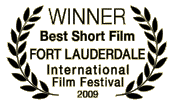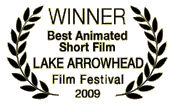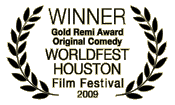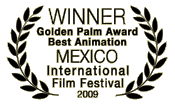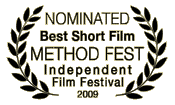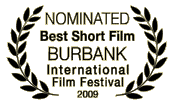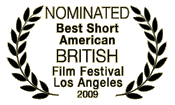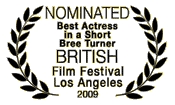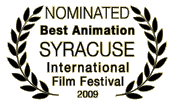Production Notes
ANIMATED AMERICAN came from an idea that Joe had, in the fall of 2003, about a ghost selling a house. Susan had recently produced an award-winning AFI short, FUELING THE FIRE, and she approached Joe to close the loop on their ongoing discussion about working together on a film that Joe could direct. Joe then approached Jim with the idea of co-directing the film, a radical but exciting departure from their days working together as feature animators at Disney. At the time, Jim was experimenting with mixing live action and CG animation.
The idea evolved as Jim and Joe brainstormed how best to blend live action and animation in a fresh way. They also decided to incorporate the real world events affecting the traditional animation industry, which seemed at the time to be headed for an early "death". What, they wondered, what would the characters like the ones in ROGER RABBIT do if they could no longer work as "toons"? The idea took final shape when they realized the story had to be much darker than had been seen before – a true film noir.
Once on that path, they quickly delivered a ten page script draft that Susan saw was basically sound, but that would benefit from a completely fresh writer that could take the story and script to the next level. Jim brought Tim Talbott, his former college roommate and a seasoned writer (SOUTH PARK, STANFORD PRISON PROJECT), into the collaboration. Jim, Joe and Susan met with Tim, who was immediately attracted to the idea and whose twisted sense of humor appealed to the filmmakers, signed on to write the script. Tim immediately demonstrated his affinity for the story and soon took it an even darker and more twisted place.
Jim and Joe then approached Jason Marsden, for whom the role of "Eric" was specifically written. He read an early draft of the script and immediately came on board with the team. He loved the idea so much that he also became an Executive Producer.
Susan introduced Jim and Joe to Ruben Russ, an AFI Fellow in cinematography. A great deal of time and effort was spent on the visual approach – the directors wanted to push the envelope of the genre far beyond the fuzzy, cutesy animated films that audiences have become accustomed. Working with Ruben, they conceived a film noir look that they then realized by filming in color but rendering the final result in black and white during the post-production process.
Jim and Joe wanted a TWILIGHT ZONE feel, where the audience and the characters are both uncertain about what is really going on. Experimenting with light, lenses and stock enabled them to give depth to shadows created by the architecture of the location.
To achieve this look Jim, Joe and Ruben established different tonalities as the movie progressed, using specific references to establish the look and tone for each act. References to achieve these looks came from the noir films such as THE BIG HEAT, OUT OF THE PAST, TOUCH OF EVIL, and more recently THE MAN WHO WASN'T THERE.
In addition, the following directors' and cinematographers' works were closely studied for blocking and camera movement:
- Robert Richardson (CASINO and NATURAL BORN KILLERS)
- Sidney Lumet (THE VEREDICT)
- Raoul Courtard
- Gordon Willis
- Eduardo Serra
- Bill Pope
- Roger Deakins (THE MAN WHO WASN'T THERE)
- Juan Ruiz Anchia
- Orson Wells (CITIZEN KANE)
- Conrad Hall (IN COLD BLOOD)
The stylistic choices were key to reinforcing the film's theme and the filmmakers consciously chose to hew to classic forms and modalities. Specifically, they chose 35mm Kodak stock, a black and white final product, and a retro score to reinforce the theme that traditional animation is still a viable art form, as relevant and vibrant today as in decades past.
In the same vein, they avoided the clichéd behavior of toon characters. The idea was to make Max Rabbit as human as possible. Max is simply an out of work actor in a live action world. Both Max and Bogie Bear exhibited a restrained acting style, devoid of the usual cartoon antics.
Monika Mikkelsen, the Casting Director, had worked with Susan on a previous project. Susan took the idea to Monika, and she loved it. Jon Polito was the first choice for the role of Max and Monika wrote an impassioned letter to him on the team's behalf. Jon's own passion for animation drew him to the project and meeting with the team sealed the deal. The search for Trixie was more difficult. Prior to Monika joining the team, close to fifty actresses had auditioned. Monika brought in Bree, and they knew they had found their Trixie. Jason felt Bill Farmer, the official voice of Disney's Goofy, would be the ideal Bogie. Bill was also invaluable during rehearsals and the shoot where he provided the voices for both Max and Bogie.
Back to the visual, Trixie's look was critical. Working with Heather Howard, Hair and Makeup artist, and Stephanie Walker, Costume Designer, several makeup and wardrobe tests where done to finalize the unique style that gave Trixie her sexy and quirky appeal.
Similarly, the filmmakers knew they needed the ideal location, a large house that would serve as a foil to Eric's huge ego. Once the location was locked, Production Designers Celine Diano and Beauchamp Fontaine Hebb went to work on creating a look that said, "high end home for sale."
With everything coming together, the next step in the creation of ANIMATED AMERICAN was to rehearse until Jason and Bree got the hang of acting opposite the "invisible rabbit", a life-size sytrofoam cutout of Max. The actors would rehearse with sytrofoam Max and then Max would be removed so that they could practice acting and interacting with the now invisible Max.
The four day shooting schedule was very tight, so the team ran and videotaped a complete rehearsal with the actors in the location. Darren Aryes, the Editor, then edited the footage to show the team how the film would play out. In essence the movie was shot twice, but this approach allowed the team to know where the pitfalls were and, in a few cases, to tweak the script to avoid them. In particular, one of the scenes in the second act was changed significantly because of the run-through.
With a crew of thirty-five, the film was shot over four days from Feb. 6th to 9th, 2004. Once practical filming was complete, the intensive process of character animation, clean-up and effects began. The animation phase was truly a community effort, with many friends of Jim and Joe lending a hand.
While Darren and the team spent weeks editing the first cut of the film, a process that was more complex than usual due to the mixing of live action and animation, Susan was also busy trying to find a partner to handle the scanning, ink and paint and compositing necessary to integrate the live action and animation. It came as something of a shock when several companies quoted costs in the hundreds of thousands of dollars for the work. Susan, realizing that she needed to find a company that was passionate about the project, contacted Clint Eland, the president of Mercury Filmworks. After her pitch, Clint was intrigued enough to request a copy of the film. After reviewing the early edit, with rough sketches to illustrate what the animation would eventually look like, Clint and Mercury Filmworks joined forces with the team. Jim, Joe and Susan flew to Vancouver to meet the Mercury Filmworks team that would spend the next three years collaborating on the film.
Music, the final critical piece, was spearheaded by composer Alan Lee Silva. Alan created several original songs for a score that ranged in tone from burlesque to tango to film noir. Composers such as Bernard Herman and Henry Mancini were used as a touchstone throughout the creation of the score.
The final phases were completed with the assistance of LaserPacific who partnered on all of the post-production alongside Wildfire's Oscar-nominated mixer, Chris David. Chris mixed Alan's score with the sound design created by the dynamic duo of Seann Dougherty and Brett Voss and dialogue and ADR supervised by Vickie Sampson.

